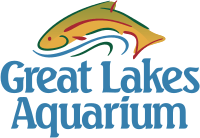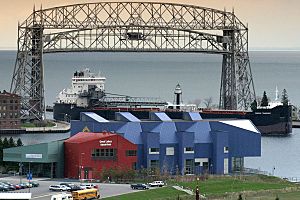Great Lakes Aquarium facts for kids
 |
|

Great Lakes Aquarium in Duluth, MN
|
|
| Date opened | July 29, 2000 |
|---|---|
| Location | Duluth, Minnesota, USA |
| Coordinates | 46°46′45.36″N 92°6′1″W / 46.7792667°N 92.10028°W |
| No. of animals | 1500 |
| No. of species | 250 |
| Volume of largest tank | 85,000 US gal (320,000 L) |
| Total volume of tanks | 175,000 US gal (660,000 L) |
The Great Lakes Aquarium is a fun place to visit in Duluth. It opened in 2000 right on the waterfront. This aquarium is special because it focuses mostly on freshwater animals. You can see creatures from the Great Lakes area and even from places like the Amazon River!
The aquarium is home to about 1,500 animals. These animals belong to 250 different species. You can find fish, birds, reptiles, amphibians, and even some mammals here. Many of the exhibits are designed to look like real places in the Lake Superior area.
Contents
History of the Aquarium
How the Aquarium Started
The Great Lakes Aquarium first opened its doors on July 29, 2000. It was built with help from the state, local groups, and many private donations. Even though many people visited at first, there were some problems. Construction delays meant the aquarium didn't earn as much money as expected.
Changes and Improvements
In 2002, the city of Duluth stepped in to help. They wanted to make sure the aquarium could stay open for a long time. For a while, a company called Ripley's Entertainment managed the aquarium. They helped save it from closing.
Later, in 2007, local leaders decided to manage the aquarium themselves again. Since 2008, they have been working hard to make it even better. They fix, replace, or remove old exhibits to keep everything fresh and exciting for visitors. They also plan new exhibits and educational programs.
Aquarium Building and Design
Building the Great Lakes Aquarium took about three and a half years. It cost around $34 million to build this amazing place. When you visit, you can ride an escalator to the top floor first. This lets you explore the "Sensory Immersion Experience" before heading down to the lower levels.
The building also has areas for events like birthday parties. From these spots, you can enjoy beautiful views of the harbor.
Main Exhibits and Animals
Isle Royale Exhibit
The Isle Royale exhibit is the biggest one at the aquarium. It holds about 85,000 gallons of water! This huge tank is right in the middle of the building. You can see it from both the first and second floors. It's home to many fish native to Minnesota, like perch, trout, and lake sturgeon.
Baptism River Exhibit
The Baptism River exhibit shows a fast-moving river with a waterfall. Here, you can see fish like kamloops and siscowet.
Saint Louis River Exhibit
The Saint Louis River exhibit is a slower-moving river habitat. It features fish like perch, walleye, sturgeon, and channel catfish. These are all species you would find in a real Saint Louis River habitat.
Otter Cove Exhibit
Otter Cove is a very popular exhibit! It's home to two North American river otters named Agate and Ore. These two female otters arrived at the aquarium in 2014. They were rescued from a crayfish farm in Louisiana. The exhibit looks like a real cove from Pukaskwa National Park in Ontario.
Amazing Amazon Exhibit
Opened in 2008, the Amazing Amazon exhibit takes you to the largest river in the world. You can see fascinating freshwater creatures from the Amazon. This includes fish like Pacu, Arowana, Piranha, Catfish, Electric Eels, and Discus.
Unsalted Seas Exhibit
The Unsalted Seas exhibit opened in 2016. It explores large lakes from all over the world and the animals that live in them. A highlight is the sturgeon touch pool, which is one of the largest in North America. You can gently touch sturgeon from Russia and North Asia, including Beluga and Sterlet sturgeon.
Raptor Ridge Exhibit
Raptor Ridge opened in 2019. It's home to two special birds: Bogey, a Bald Eagle, and Horus, a Turkey Vulture. These birds cannot be released back into the wild. This exhibit teaches visitors about birds of prey, their migration, and how they are cared for.
Origins Exhibit
The Origins exhibit takes you on a journey through Earth's history. It shows how life has changed over time, from before animals appeared to today. You can see animals like Corals, Invertebrates, Alligators, Grayling, Opossums, and Skunks.
Wild Neighbors Exhibit
The Wild Neighbors exhibit features animals you might find right outside your own home! It includes a crow, snakes, frogs, turtles, and chipmunks. This exhibit helps you learn about the local ecosystem around us.
Aquatic Invaders Exhibit
This exhibit teaches about invasive species. These are plants or animals that are not native to an area and can harm the local environment.
Other Cool Features
Throughout the aquarium, you'll find smaller tanks with fish, frogs, salamanders, and snakes. There are also many interactive electronic exhibits where you can learn more. The Great Lakes Aquarium also has a local history center, a science center, and cultural exhibits.
Special Rotating Exhibits
The Great Lakes Aquarium often has special exhibits that change over time. These are called "rotating exhibits."
In July 2014, an exhibit called "Shipwrecks Alive!" opened. It showed how sea life makes homes in shipwrecks. It even featured the story of the SS America, a ship that sank near Isle Royale in 1918.
Another past exhibit was "Masters of Disguise," which opened in May 2010. This exhibit explored how animals use camouflage, colors, and mimicry to hide. You could see fish that change shape, insects that look like plants, and reptiles that change color!
Other past rotating exhibits included "The Abyss: the Great Unknown" and "Africa's Lake Victoria."



